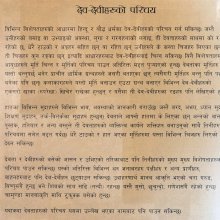Pustaka: 24 definitions
Introduction:
Pustaka means something in Buddhism, Pali, Hinduism, Sanskrit, the history of ancient India, Marathi, Hindi. If you want to know the exact meaning, history, etymology or English translation of this term then check out the descriptions on this page. Add your comment or reference to a book if you want to contribute to this summary article.
Alternative spellings of this word include Pustak.
Images (photo gallery)
In Hinduism
Shilpashastra (iconography)
Source: Google Books: Elements of Hindu iconographyPustaka (पुस्तक) means a book. It is made up either of palm leaves or of paper, the latter variety being, however, comparatively modern. In older sculptures it is always a palm leaf book that is represented as being held in the hand by Brahmā and other deities.
Source: Google Books: Sarasvatī: Riverine Goddess of Knowledge (iconography)Pustaka (पुस्तक, “book”).—An object being held by the four-armed Sarasvatī;—The pustaka clearly belongs to the goddess of knowledge and is found in the earliest known image of Sarasvatī from about the third century C.E. The Viṣṇudharmottara-purāṇa says her hands (four in number) represents the Vedas, and her book, all Śāstras (scriptures).
Source: Red Zambala: Hindu Icons and Symbols | DeviPustaka (Book) - The sacred Scriptures and all forms of book learning and theoretical knowledge. In the modern context it would include computers and all other forms of visual and sound media as well.
Source: Red Zambala: Hindu Icons and Symbols | IntroductionPustaka (Book) - The Vedas – sacred Scriptures and the formal learning of all sorts of knowledge and theory.
Source: Shodhganga: The significance of the mūla-beras (śilpa)Pustaka (पुस्तक, “book”) refers to one of the several “attributes” (āyudha) or “accessories” of a detiy commonly seen depicted in Hindu iconography, defined according to texts dealing with śilpa (arts and crafs), known as śilpaśāstras.—The śilpa texts have classified the various accessories under the broad heading of āyudha or karuvi (implement), including even flowers, animals, and musical instruments. Certain utensils and other objects that are commonly found in the hands of the images are, for example Pustaka.
Pustaka means a book. It is made up either of palm leaves or of paper. In older sculptures it is always a palm leaf book that is represented as being held in the hand by Brahmā and other deities.

Shilpashastra (शिल्पशास्त्र, śilpaśāstra) represents the ancient Indian science (shastra) of creative arts (shilpa) such as sculpture, iconography and painting. Closely related to Vastushastra (architecture), they often share the same literature.
Shaktism (Shakta philosophy)
Source: Wisdom Library: ŚāktismPustaka (पुस्तक, “book”).—One of the symbols that Sarasvatī is depicted as holding in one of her hands. It symbolizes all forms of learning and theoretical knowledge.
Source: Google Books: ManthanabhairavatantramPustaka (पुस्तक) refers to “books”, according to the Manthānabhairavatantra, a vast sprawling work that belongs to a corpus of Tantric texts concerned with the worship of the goddess Kubjikā.—Accordingly, “[...] Practice Yoga [i.e., yogābhyāsa] in the sphere of the Supreme Syllable. The thread (sūtra) of the Supreme Syllable is the heart that fulfils all desires. He who, established in the venerable (goddess) Kujā, knows (this) is liberated from the bondage of birth. (Perfect) contemplation (samādhi) is with (these) sixteen aspects and is (attained) within the form of the sixfold deposition (ṣoḍhānyāsa). He who knows this is (a veritable) Lord of Yogis, the others (who do not) are (just) quoting from books [i.e., pustaka-vācaka]. Once attained the plane that is Void and Non-void, the yogi is freed from bondage”.
Source: Brill: Śaivism and the Tantric Traditions (shaktism)Pustaka (पुस्तक) refers to a “book”, according to the King Vatsarāja’s Pūjāstuti called the Kāmasiddhistuti (also Vāmakeśvarīstuti), guiding one through the worship of the Goddess Nityā.—Accordingly, “[...] May goddess Bhāratī shine upon me, I pray. She carries a rosary and a book (pustaka-dharā) in her hands, she has the stainless complexion of the full moon, and she embodies the entirety of knowledge. I venerate the beloved husband of Rati, the beautiful Mind-born [God Kāmadeva]. He carries a bow and arrows of flowers and his complexion resembles the petals of Dhak. [Again,] I approach the beloved husband of Prīti, bent round like the full moon, [serving as] the base for the ring of goddesses, in order to draw the Śrīcakra for the sake of prosperity. [...]”.

Shakta (शाक्त, śākta) or Shaktism (śāktism) represents a tradition of Hinduism where the Goddess (Devi) is revered and worshipped. Shakta literature includes a range of scriptures, including various Agamas and Tantras, although its roots may be traced back to the Vedas.
Shaivism (Shaiva philosophy)
Source: SOAS University of London: Protective Rites in the Netra TantraPustaka (पुस्तक) refers to a “book”, according to the Netratantra of Kṣemarāja: a Śaiva text from the 9th century in which Śiva (Bhairava) teaches Pārvatī topics such as metaphysics, cosmology, and soteriology.—Accordingly, [verse 13.25cd-28, while describing the appearance and worship of Viśvakarman]—“Furthermore, [I shall describe] Viśvakarman, the Lord of the world. [He] is bright as a ray of light, risen alone [i.e., from itself]. [Viśvakarman] has [either] two or four arms. [When he has four hands he] bears a stone cutter’s chisel and a book (pustaka—ṭaṅkapustakadhāriṇam) with [his] beautiful right hand. [In the left he holds] a clamp and a cord. [...]”.

Shaiva (शैव, śaiva) or Shaivism (śaivism) represents a tradition of Hinduism worshiping Shiva as the supreme being. Closely related to Shaktism, Shaiva literature includes a range of scriptures, including Tantras, while the root of this tradition may be traced back to the ancient Vedas.
In Buddhism
Mahayana (major branch of Buddhism)
Source: academia.edu: A Study and Translation of the GaganagañjaparipṛcchāPustaka (पुस्तक) refers to a “book” (containing the teaching of the Buddha), according to the Gaganagañjaparipṛcchā: the eighth chapter of the Mahāsaṃnipāta (a collection of Mahāyāna Buddhist Sūtras).—Accordingly, as the Brahmā (the lord of Sahā) addressed himself to the Lord: “[...] As for the dharma-reciters, who, having collected this teaching of the Buddha, understand it, retain it, read it, teach it, and make it into a book (pustaka), wherever they hold religious discourses in the wilderness, forest, village, city, town, kingdom or capital, if they explain this exposition of the dharma in detail, then we will protect them, shield them, guard them, rejoice them, fulfill energy, attain recollection, acquire intelligence, be accordance with realization, fulfill eloquence, inspire the unbelieving with faith, and liberate those who have faith. According to the Tathāgata’s guiding principle of the dharma, Lord, we will uphold and disseminate it”.

Mahayana (महायान, mahāyāna) is a major branch of Buddhism focusing on the path of a Bodhisattva (spiritual aspirants/ enlightened beings). Extant literature is vast and primarely composed in the Sanskrit language. There are many sūtras of which some of the earliest are the various Prajñāpāramitā sūtras.
Tibetan Buddhism (Vajrayana or tantric Buddhism)
Source: Brill: Śaivism and the Tantric Traditions (tantric Buddhism)Pustaka (पुस्तक) refers to “books” (of the Prajñāpāramitā), according to the Nāmamantrārthāvalokinī by Vilāsavajra, which is a commentary on the Nāmasaṃgīti.—Accordingly, [while describing Mañjuśrī-jñānasattva]—“[Next] he should visualise himself as the fortunate one, the gnosis-being [Mañjuśrī], born from the syllable a situated in the middle of that [wisdom-] wheel [situated in the heart of the Ādibuddha]. He has six faces, is radiant like the autumn moon, with the best of sapphires in his beautiful hair, with a halo that has the brilliance of the orb of the newly risen sun, with all the Tathāgatas as [head-]ornaments, immersed in meditative concentration, seated on a variagated lotus throne, in tranquil mood, with a pair of books (pustaka-dvaya) of the Prajñāpāramitā above blue lotuses held in his two hands”.

Tibetan Buddhism includes schools such as Nyingma, Kadampa, Kagyu and Gelug. Their primary canon of literature is divided in two broad categories: The Kangyur, which consists of Buddha’s words, and the Tengyur, which includes commentaries from various sources. Esotericism and tantra techniques (vajrayāna) are collected indepently.
India history and geography
Source: Cologne Digital Sanskrit Dictionaries: Indian Epigraphical GlossaryPustaka.—cf. Tamil pottagam (SITI); register, as of land and revenue. Note: pustaka is defined in the “Indian epigraphical glossary” as it can be found on ancient inscriptions commonly written in Sanskrit, Prakrit or Dravidian languages.

The history of India traces the identification of countries, villages, towns and other regions of India, as well as mythology, zoology, royal dynasties, rulers, tribes, local festivities and traditions and regional languages. Ancient India enjoyed religious freedom and encourages the path of Dharma, a concept common to Buddhism, Hinduism, and Jainism.
Languages of India and abroad
Marathi-English dictionary
Source: DDSA: The Molesworth Marathi and English Dictionarypustaka (पुस्तक).—n (S) A book. pustakāṃvarūna ōḍhaṇēṃ To run over books cursorily; to be a superficial scholar or a smatterer.
Source: DDSA: The Aryabhusan school dictionary, Marathi-Englishpustaka (पुस्तक).—A book. pustakāṃvaruna ōḍhaṇēṃ To run over books cursorily;to be a smatterer.
Marathi is an Indo-European language having over 70 million native speakers people in (predominantly) Maharashtra India. Marathi, like many other Indo-Aryan languages, evolved from early forms of Prakrit, which itself is a subset of Sanskrit, one of the most ancient languages of the world.
Sanskrit dictionary
Source: DDSA: The practical Sanskrit-English dictionaryPustaka (पुस्तक).—
1) A book, manuscript.
2) A protuberant ornament, boss.
-āgāram a library.
-āstaraṇam The wrapper of a manuscript; Hch.
-mudrā a kind of mudrā mentioned in Tantraśāstra; वाममुष्टिं स्वाभिमुखीं कृत्वा पुस्तकमुद्रिका (vāmamuṣṭiṃ svābhimukhīṃ kṛtvā pustakamudrikā).
-pustikāpūlikaḥ a collection of manuscripts; Hch.3.
Derivable forms: pustakaḥ (पुस्तकः), pustakam (पुस्तकम्).
Source: Cologne Digital Sanskrit Dictionaries: Shabda-Sagara Sanskrit-English DictionaryPustaka (पुस्तक).—nf. (-kaṃ-kī) A book, a manuscript. E. kan added to the last.
Source: Cologne Digital Sanskrit Dictionaries: Benfey Sanskrit-English DictionaryPustaka (पुस्तक).—[pusta + ka], m. and n. A book, a manuscript, [Pañcatantra] 127, 2.
Source: Cologne Digital Sanskrit Dictionaries: Cappeller Sanskrit-English DictionaryPustaka (पुस्तक).—[masculine] pustikā [feminine] the same.
Source: Cologne Digital Sanskrit Dictionaries: Monier-Williams Sanskrit-English Dictionary1) Pustaka (पुस्तक):—[from pusta] m. or n. a protuberant ornament, boss (See below)
2) [v.s. ...] mf(ikā)n. a manuscript, book, booklet, [Harivaṃśa; Kāvya literature; Varāha-mihira etc.]
Source: Cologne Digital Sanskrit Dictionaries: Yates Sanskrit-English DictionaryPustaka (पुस्तक):—[(kaṃ-kī)] 1. n. 3. f. A book.
[Sanskrit to German]
Sanskrit, also spelled संस्कृतम् (saṃskṛtam), is an ancient language of India commonly seen as the grandmother of the Indo-European language family (even English!). Closely allied with Prakrit and Pali, Sanskrit is more exhaustive in both grammar and terms and has the most extensive collection of literature in the world, greatly surpassing its sister-languages Greek and Latin.
Hindi dictionary
Source: DDSA: A practical Hindi-English dictionaryPustaka (पुस्तक) [Also spelled pustak]:—(nf) a book; ~[kakāra] writer/author of a book; ~[kīya] [jñāna] bookish knowledge.
...
Kannada-English dictionary
Source: Alar: Kannada-English corpusPustaka (ಪುಸ್ತಕ):—
1) [noun] a number of sheets of paper, parchment, etc. with writing or printing on them, fastened together along one edge, usu. between protective covers; a book.
2) [noun] (jain.) a class of jaina sages or mendicants.
3) [noun] ಪುಸ್ತಕದ ಬದನೆಕಾಯಿ [pustakada badanekayi] pustakada badanekāyi knowledge got by mere book learning, lacking common sense, practicability or application to useful ends; ಪುಸ್ತಕದ ಹುಳು [pustakada hulu] pustakada huḷu = ಪುಸ್ತಕಕೀಟ [pustakakita]; ಪುಸ್ತಕ ನೋಡಿಸು [pustaka nodisu] pustaka nōdisu to get opened a page randomly in a sacred book and interpreted its content as if it would apply or would give a clue to the future event.
Kannada is a Dravidian language (as opposed to the Indo-European language family) mainly spoken in the southwestern region of India.
See also (Relevant definitions)
Starts with (+21): Pushtakari, Pushtakavacana, Pustaka-bhakti, Pustaka-bhandara, Pustaka-kharca, Pustaka-premi, Pustaka-sangraha, Pustaka-sangrahaka, Pustaka-vikreta, Pustakabhyasa, Pustakadhara, Pustakadharin, Pustakadharini, Pustakadhyaksha, Pustakadvaya, Pustakagaccha, Pustakagara, Pustakahasta, Pustakakar, Pustakakara.
Ends with (+5): Bhandara-pustaka, Bhiramvadekariyacem Pustaka, Brahmakarmapustaka, Dakhalepustaka, Dartapustaka, Dharmapustaka, Dvipustaka, Gitapustaka, Jainamatapustaka, Kaddipustaka, Kaipustaka, Khatepustaka, Manepustaka, Mapushtaka, Nibandhapustaka, Notupustaka, Parapindapushtaka, Pathyapustaka, Pothipustaka, Pratipustaka.
Full-text (+64): Gitapustaka, Pratipustaka, Pusta, Gitapustakasamgraha, Pustakakara, Ati-mulapustakam, Pustakagaccha, Pustaka-premi, Pustaka-sangrahaka, Pustaka-kharca, Maranapustakam, Vetapustakam, Vratapustaka, Postakam, Pustaka-bhandara, Pustak-premi, Shantipustaka, Sarvalakshanapustaka, Tiru-catankupustakam, Vaishyakarmapustaka.
Relevant text
Search found 25 books and stories containing Pustaka; (plurals include: Pustakas). You can also click to the full overview containing English textual excerpts. Below are direct links for the most relevant articles:
Garga Samhita (English) (by Danavir Goswami)
Verse 5.21.43 < [Chapter 21 - The Story of Śrī Nārada]
The Agni Purana (by N. Gangadharan)
Middle Chola Temples (by S. R. Balasubrahmanyam)
Temples in Chikka Hansoge < [Chapter IV - Temples of Rajendra I’s Time]
Chaitanya Bhagavata (by Bhumipati Dāsa)
Verse 1.12.245 < [Chapter 12 - The Lord’s Wandering Throughout Navadvīpa]
Verse 1.7.115 < [Chapter 7 - Śrī Viśvarūpa Takes Sannyāsa]
Verse 1.5.2 < [Chapter 5 - Eating the Mendicant Brāhmaṇa’s Offerings]
Vietnamese Buddhist Art (by Nguyen Ngoc Vinh)
4. Avalokitesvara images in Cambodia < [Chapter 3 - Unifying factors of the Avalokitesvara Images in South Vietnam and South East Asia]
3. Avalokitesvara images in Funan < [Chapter 3 - Unifying factors of the Avalokitesvara Images in South Vietnam and South East Asia]
Related products



